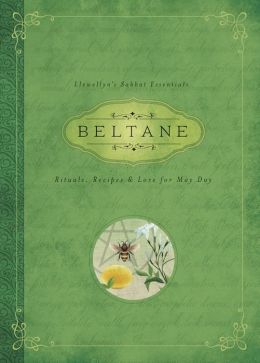I'll be honest: when I first got this book in the mail, I was a little disappointed in its size. I was expecting a full-sized book, and this one just came off as a pocket guide. It measures all of five inches by seven inches and a half inch thick.
Then I opened it and started to read. Wow, was I wrong.
Most of the Pagan 101 books out there cover a little bit about each Sabbat. There are some that delve into *just* the Sabbats. There are a few that are dedicated to each individual Sabbat. I'm impressed by the depth of this small volume on Beltane.
It starts with an introduction that covers the basics of what the Sabbats are and why this series of eight books is being published. Since this is the first one I've gotten my hands on, I assume that the Introduction section is going to be the same information in each of the Sabbat books. It also discusses the modern Pagan's view of the Sabbats, which is a nice touch, considering that more and more of us are urban dwellers with a less tenuous and less personal connection to nature than our forebears.
Next comes the history section, which is much more detailed than one would expect. There are even citations, which is extremely rare in a less academic, more practical Craft book. It covers the "Old Ways" of worship and some of the various myths and celebrations associated with Beltane, some of which are well known (lusty Horned God has his beasty way with the Triple Goddess in her Maiden form), and some of which many have either not heard of (the Roman festival of Floralia) or had forgotten. It discusses different ways that our ancestors may have celebrated, with flowers or water or the May Pole or good, old-fashioned fertility and consummation rites.
From there, it moves into "New Ways," how we, as modern Pagans, handle holy days from a more agrarian past. It covers both rural and urban practitioners and briefly touches on how each may move through the energy of the Sabbat. It turns an eye toward how some different paths (Celtic Reconstructionist, Wicca, Heathen, Modern Druid, Traditional Witchcraft, Neopagan, Eclectic Witchcraft) may celebrate. It lists out some varied festivals around the world that are dedicated to different Aspects of Beltane. It also covers what some of the more modern ways to bring out more ancient themes would look like.
From there, we move to the more practical applications: Spells and Divination has spells for love, purification, abundance, and divination using eggs, flowers, tarot. Recipes and Crafts has custard, berries, yogurt, coffee, an entire Beltane-themed barbecue, wands, crowns, maypoles, and decorating tips, both indoors and outdoors. There are prayers and invocations to the Green Man, the Sun, Belenos, the Earth Goddess, Flora, for protection, to the Faeries. There are rituals for solitary practitioners, for groups, for handfasting. The final sections are correspondences, a reading list, and the bibliography (which is much more extensive than I've seen in a long time!).
At first glance, the size of the book doesn't lead me to want to spend $12 on it. After reading through it, though, this book is well worth the price. The information is solid, if not exhaustive, but I can't think of anyone who should ever expect an exhaustive book on anything. Excellent job, Llewellyn, on expanding the Sabbat knowledge.
Author: Melanie Marquis
Llewellyn Worldwide, 2015
222 pages, $11.99
Beltane: Rituals, Recipes, and Lore for May Day

©
2010 - 2025
Facing North
